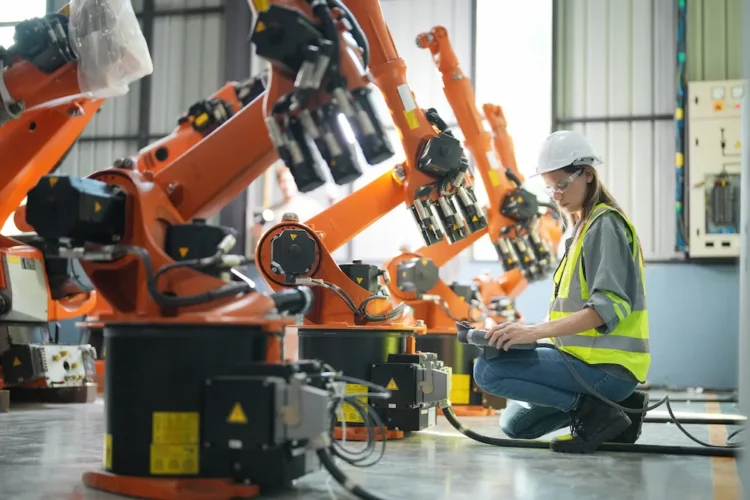Energy consumption is a pressing concern in the manufacturing sector, accounting for a significant portion of operational costs and environmental impact. As industries seek innovative solutions to enhance efficiency and sustainability, collaborative robots, or cobots, are emerging as key players in reducing energy consumption. This article explores how cobots can transform manufacturing processes, leading to more sustainable and energy-efficient operations.
The Role of Energy Efficiency in Manufacturing
Manufacturing is one of the largest consumers of energy worldwide, with many facilities grappling with rising energy costs and the environmental consequences of their operations. In recent years, the spotlight has been on energy efficiency, which is not only a regulatory requirement but also a strategic necessity for companies aiming to enhance their competitiveness.
High energy consumption has significant environmental implications, contributing to a larger carbon footprint that exacerbates climate change. Many governments are imposing stricter regulations to combat this, compelling manufacturers to adopt greener practices. The economic benefits of reducing energy consumption are equally compelling. By lowering energy bills, manufacturers can realize substantial cost savings, which can then be reinvested into other areas of the business, fostering growth and innovation.
How Collaborative Robots Contribute to Energy Reduction
Collaborative robots are designed to work alongside humans, enhancing productivity and efficiency without the need for extensive safety measures typically associated with traditional industrial robots. Their integration into manufacturing processes can lead to significant reductions in energy consumption through various mechanisms.
Enhancing Operational Efficiency
Cobots can streamline production processes by automating repetitive and mundane tasks. By taking over these duties, cobots allow human workers to focus on more complex tasks that require creativity and critical thinking. This division of labor minimizes downtime and reduces waste, contributing to overall energy efficiency.
Precision and Consistency in Tasks
One of the defining features of cobots is their ability to perform tasks with high precision and consistency. This reduces errors and the need for rework, which can be both time-consuming and energy-intensive. When production lines run smoothly with fewer mistakes, energy consumption decreases, creating a more efficient manufacturing environment.
Flexibility in Production Lines
Cobots bring remarkable flexibility to manufacturing processes. They can be easily reprogrammed and adapted to meet changing production demands, which reduces the need for energy-intensive machinery that may only be required for specific tasks. This adaptability ensures that manufacturers are not locked into rigid processes that waste energy during downtime.
For more insights into robotics and energy efficiency in manufacturing, visit robot site.
Future Trends in Collaborative Robotics and Energy Efficiency
As technology evolves, so does the potential for cobots to further contribute to energy efficiency in manufacturing.
Technological Advancements in Cobot Capabilities
The integration of artificial intelligence in collaborative robots is a game changer for energy management. AI allows cobots to analyze energy consumption patterns in real-time, enabling them to optimize their operations for maximum efficiency. For example, cobots can adjust their speed and power usage based on workload, ensuring they operate at peak efficiency without unnecessary energy expenditure.
Increasing Adoption in Various Sectors
While cobots are primarily associated with manufacturing, their potential extends into various sectors, including healthcare and logistics. As more industries recognize the advantages of collaborative robots, we can expect a significant reduction in global energy consumption. The transition towards sustainable practices is no longer a trend but an essential element of modern business strategy.
Implementation Strategies for Manufacturers
For manufacturers looking to leverage collaborative robots to reduce energy consumption, a strategic approach is essential.
Assessing Energy Consumption and Identifying Opportunities
Conducting a thorough energy audit is the first step toward identifying opportunities for improvement. By analyzing current energy usage, manufacturers can set realistic reduction targets and pinpoint areas where cobots can make the most significant impact.
Choosing the Right Collaborative Robots
Selecting the appropriate cobots involves understanding the specific needs of the manufacturing process. Factors such as task complexity, workspace conditions, and integration capabilities should guide the selection process. Collaborating with vendors that provide comprehensive support and training can facilitate smoother transitions.
Training and Workforce Adaptation
As cobots take on more responsibilities, it is crucial to prepare employees for this change. Providing training programs that focus on collaboration with robots ensures that workers feel empowered rather than threatened by the technology. Continuous learning opportunities will help the workforce adapt to evolving roles within the manufacturing landscape.
Conclusion
The journey toward reducing energy consumption in manufacturing is increasingly reliant on the integration of collaborative robots. By enhancing operational efficiency, precision, and flexibility, cobots are transforming traditional manufacturing processes into sustainable operations. As technology continues to advance, the potential for cobots to drive energy efficiency will only grow, paving the way for a more sustainable future in manufacturing.
Manufacturers must take proactive steps to explore these solutions and harness the benefits that cobots offer. By doing so, they not only contribute to a greener planet but also position themselves for long-term success in an evolving marketplace.



